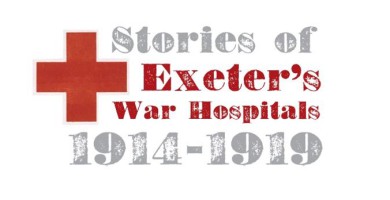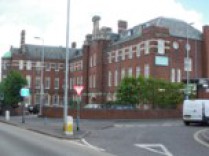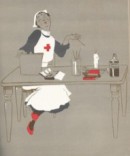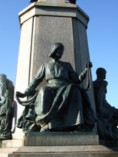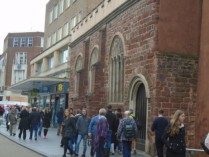
13 April 2017 - Jurys Inn at 7pm
After a frantic half hour delay due to equipment failure, Dr Julia Neville, having displayed magnificent patience, was at last able to display many extraordinary slides illuminating for us the steps Exeter took to treat the wounded of World War I.
In all, over 35,000 patients were treated and by 1917 there were over 1100 beds here in eight hospitals, although they started on a much smaller scale.
The official plan was to mobilise a military hospital at Plymouth but two days after war broke out the Red Cross were asked to set up hospital provision in Exeter. They did and within a few weeks the first two hospitals were ready. The Eye Infirmary (now the Hotel du Vin – left) became hospital no.1.
By 1915 there was a fifth hospital in Castle Street, then two more in 1917 and by 1918 private houses around Southernhay were requisitioned to lodge patients requiring outpatient treatment (known collectively as hospital no. 8). All this was organised by the redoubtable Georgiana Buller – the only female administrator of any war hospital. She went on, of course, to found the Princess Elizabeth Orthopaedic Hospital in Exeter and the St Loye's College for Training the Disabled.
Many do not realise that there were almost twice as many wounded on the first day of the Somme as those killed. One week after the first day of that battle, a train arrived in Exeter with a convoy of 200 wounded. Over half of these, 110 patients, were stretcher cases, unable to walk to the waiting ambulances.
The Battle of Vimy Ridge, though an Allied victory, meant a total of 260 stretcher cases and 80 walking wounded needing help in our hospitals in April 1917 (exactly 100 years ago).
Then the fighting in the Ypres Salient and at Passchendaele, which has passed into memory as shorthand for mud, blood and terrible losses, provided more and more casualties for our hospitals.
We retraced some of the journeys the patients took. Casualties would be taken for initial treatment to posts in the field and from there they would be transported in somewhat rough and ready field ambulances to ‘stationary’ hospitals behind the lines. If they made it that far, it was estimated that they had a fifty/fifty chance of survival.
From there, soldiers who were considered fit enough to travel would be shipped across the channel to Dover or Southampton. Specially designed ambulance trains took the wounded to Exeter from Southampton - the direct rail link meant Exeter was a prime destination.
The list of war wounds was horrific – eyes damaged or destroyed, gas poisoning, peritonitis, gun shot and shrapnel wounds and septic poisoning from wounds. Apart from the obvious war wounds the patients also had many illnesses needing attention – frostbite, typhoid, dysentery, delirium, influenza and pleurisy.
By our standards, there was little that could be done for the patients. Penicillin was yet to be discovered. Treatments offered were:
|
Operations Splints Sera, vaccines and ‘dosing’ Enemas Massage and electrical therapy Bathing Cleanliness and antiseptics Rest and self-healing. And fresh air ! |
The Red Cross nurses – identified by the red cross on their uniforms – were officially known as VADs (Volunteer Aid Detachments) and nursed alongside the trained and paid nurses.
The lives of some of the nurses are revealed to us through their diaries. In particular, one nurse wrote a series of poems which were illustrated with little cartoons by another nurse, Joyce Dennys. These were recorded alphabe-tically each with their own cartoon, as in:
A is for artist who, stuck on night duty
Drew this by candlelight, wrecking her beauty
Those who died in our war hospitals were laid to rest in a dedicated portion of the Higher Cemetery where now a war memorial stands. To the town council’s shame, nurses who died in the war hospitals were refused a war grave. In expiation perhaps – for it was a controversial decision - the city war memorial in Northernhay Gardens does show the figure of a nurse.
The whole population of Exeter and the surrounding districts supported the injured, with treats (cigarettes, newspapers, bagatelle boards, a gramophone) and extra food (home-grown fruit and vegetables, cake, jam, and game and salmon from the owners of landed estates). For Christmas in 1917, 4230 parcels, each containing a “woolly”, a pipe, knife, fountain pen, tobacco, cigarettes, sweets and a book were provided for every patients. People knitted and sewed to provide bed linen, dressings, pyjamas, shirts and splints while artistes from the Hippodrome and the Theatre Royal gave concerts. As did local bands and pierrot troupes – even the Exeter Cycling Club put on concerts and organised games and in the summer trips by car and charabanc to Teignmouth and Torquay were organised.
As patients recovered, they might return to base for further service at the front or be transferred to non-combat duties. Many were discharged as unfit, needing long term care or support in obtaining employment. Some were sent to convalesce in another hospital or were transferred for more specialist treatment, such as at Seale Hayne which dealt with shell shock.
In closing, we learnt about the Exeter War Hospital Exhibition scheduled for 19-23 September at St Stephens Church in the High Street. This will feature the many items collected by Julia and her colleagues. There will be any number of fascinating artefacts donated or lent by relatives of the patients and staff of the War Hospitals in Exeter in 1914-19, with copies of magazines produced by patients and staff, autograph albums kept by the nurses, and a clinical area showing treatments and nursing items of the time.
Volunteers are also needed and, if anyone could spare a few hours to help as a volunteer guide, please do contact us at exeterlocalhistory@gmail.com.
